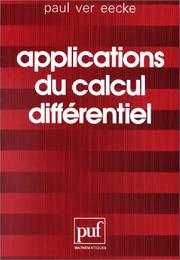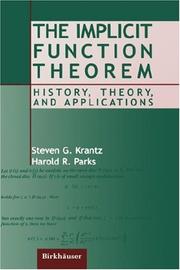| Listing 1 - 4 of 4 |
Sort by
|
Book
Year: 1980 Publisher: Liège : Université de Liège - Institut de Mathématique,
Abstract | Keywords | Export | Availability | Bookmark
 Loading...
Loading...Choose an application
- Reference Manager
- EndNote
- RefWorks (Direct export to RefWorks)
Variétés (mathématiques) --- Fonctions implicites. --- Manifolds (Mathematics) --- Implicit functions. --- Variétés topologiques

ISBN: 2130389619 Year: 1985 Publisher: Paris : PUF,
Abstract | Keywords | Export | Availability | Bookmark
 Loading...
Loading...Choose an application
- Reference Manager
- EndNote
- RefWorks (Direct export to RefWorks)

ISBN: 0817642854 9780817642853 1461265932 1461200598 3764342854 Year: 2002 Publisher: Boston : Birkhäuser,
Abstract | Keywords | Export | Availability | Bookmark
 Loading...
Loading...Choose an application
- Reference Manager
- EndNote
- RefWorks (Direct export to RefWorks)
The implicit function theorem is part of the bedrock of mathematics analysis and geometry. Finding its genesis in eighteenth century studies of real analytic functions and mechanics, the implicit and inverse function theorems have now blossomed into powerful tools in the theories of partial differential equations, differential geometry, and geometric analysis. There are many different forms of the implicit function theorem, including (i) the classical formulation for Ck functions, (ii) formulations in other function spaces, (iii) formulations for non-smooth function, (iv) formulations for functions with degenerate Jacobian. Particularly powerful implicit function theorems, such as the Nash-Moser theorem, have been developed for specific applications (e.g., the imbedding of Riemannian manifolds). All of these topics, and many more, are treated in the present volume. The history of the implicit function theorem is a lively and complex store, and intimately bound up with the development of fundamental ideas in analysis and geometry. This entire development, together with mathematical examples and proofs, is recounted for the first time here. It is an exciting tale, and it continues to evolve. The Implicit Function Theorem is an accessible and thorough treatment of implicit and inverse function theorems and their applications. It will be of interest to mathematicians, graduate/advanced undergraduate stunts, and to those who apply mathematics. The book unifies disparate ideas that have played an important role in modern mathematics. It serves to document and place in context a substantial body of mathematical ideas.
Implicit functions --- Engineering & Applied Sciences --- Applied Mathematics --- Fonctions implicites --- Mathematical analysis --- Mathematical analysis. --- Analysis (Mathematics). --- Partial differential equations. --- Differential geometry. --- Mathematics. --- History. --- Analysis. --- Partial Differential Equations. --- Differential Geometry. --- History of Mathematical Sciences. --- Annals --- Auxiliary sciences of history --- Math --- Science --- Differential geometry --- Partial differential equations --- 517.1 Mathematical analysis

ISBN: 9780387954820 0387954821 9780387227467 1468492519 1280009764 0387227466 9786610009763 Year: 2003 Volume: 153 Publisher: New York, NY : Springer New York : Imprint: Springer,
Abstract | Keywords | Export | Availability | Bookmark
 Loading...
Loading...Choose an application
- Reference Manager
- EndNote
- RefWorks (Direct export to RefWorks)
This book is an introduction to level set methods and dynamic implicit surfaces. These are powerful techniques for analyzing and computing moving fronts in a variety of different settings. While the book gives many examples of the usefulness of the methods for a diverse set of applications, it also gives complete numerical analysis and recipes, which will enable users to quickly apply the techniques to real problems. The book begins with the description of implicit surfaces and their basic properties, and then devises the level set geometry and calculus toolbox, including the construction of signed distance functions. Part II adds dynamics to this static calculus. Topics include the level set equation itself, Hamilton-Jacobi equations, motion of a surface normal to itself, reinitialization to a signed distance function, extrapolation in the normal direction, the particle level set method, and the motion of codimension two (and higher) objects. Part III is concerned with topics taken from the field of image processing and computer vision. These include the restoration of images degraded by noise and blur, image segmentation with active contours (snakes), and reconstruction of surfaces from unorganized data points. Part IV is dedicated to computational physics. It begins with one-phase compressible fluid dynamics, then two-phase compressible flow involving possibly different equations of state, detonation and deflagration waves, and solid/fluid structure interaction. Next it discusses incompressible fluid dynamics, including a computer graphics simulation of smoke; free surface flows, including a computer graphics simulation of water; and fully two-phase incompressible flow. Additional related topics include incompressible flames with applications to computer graphics and coupling a compressible and incompressible fluid. Finally, heat flow and Stefan problems are discussed. A student or researcher working in mathematics, computer graphics, science, or engineering interested in any dynamic moving front, which might change it's topology or develop singularities, will find this book interesting and useful.
Level set methods. --- Implicit functions. --- Fonctions implicites --- Level set methods --- Implicit functions --- 514.8 --- 681.3*G18 --- Level sets (Mathematics) --- Osher-Sethian level set methods --- Sethian level set methods, Osher --- -Interfaces (Physical sciences) --- Functions, Implicit --- Functions of several real variables --- Geometric study of objects of mechanics and physics --- Partial differential equations: difference methods; elliptic equations; finite element methods; hyperbolic equations; method of lines; parabolic equations (Numerical analysis) --- Mathematics --- Physical Sciences & Mathematics --- Mathematics - General --- Physics --- Atomic Physics --- Mathematical Theory --- 681.3 *G18 Partial differential equations: difference methods; elliptic equations; finite element methods; hyperbolic equations; method of lines; parabolic equations (Numerical analysis) --- 514.8 Geometric study of objects of mechanics and physics --- -Functions, Implicit --- Mathematics. --- Image processing. --- Computer mathematics. --- Continuum physics. --- Mechanics. --- Mechanics, Applied. --- Computational Mathematics and Numerical Analysis. --- Classical Continuum Physics. --- Image Processing and Computer Vision. --- Theoretical and Applied Mechanics. --- 681.3 *G18 --- Computer science --- Computer vision. --- Mechanics, applied. --- Classical and Continuum Physics. --- Optical data processing. --- Applied mechanics --- Engineering, Mechanical --- Engineering mathematics --- Classical mechanics --- Newtonian mechanics --- Dynamics --- Quantum theory --- Optical computing --- Visual data processing --- Bionics --- Electronic data processing --- Integrated optics --- Photonics --- Computers --- Classical field theory --- Continuum physics --- Continuum mechanics --- Computer mathematics --- Optical equipment --- Méthodes d'ensembles de niveaux --- Representation des surfaces
| Listing 1 - 4 of 4 |
Sort by
|

 Search
Search Feedback
Feedback About
About Help
Help News
News